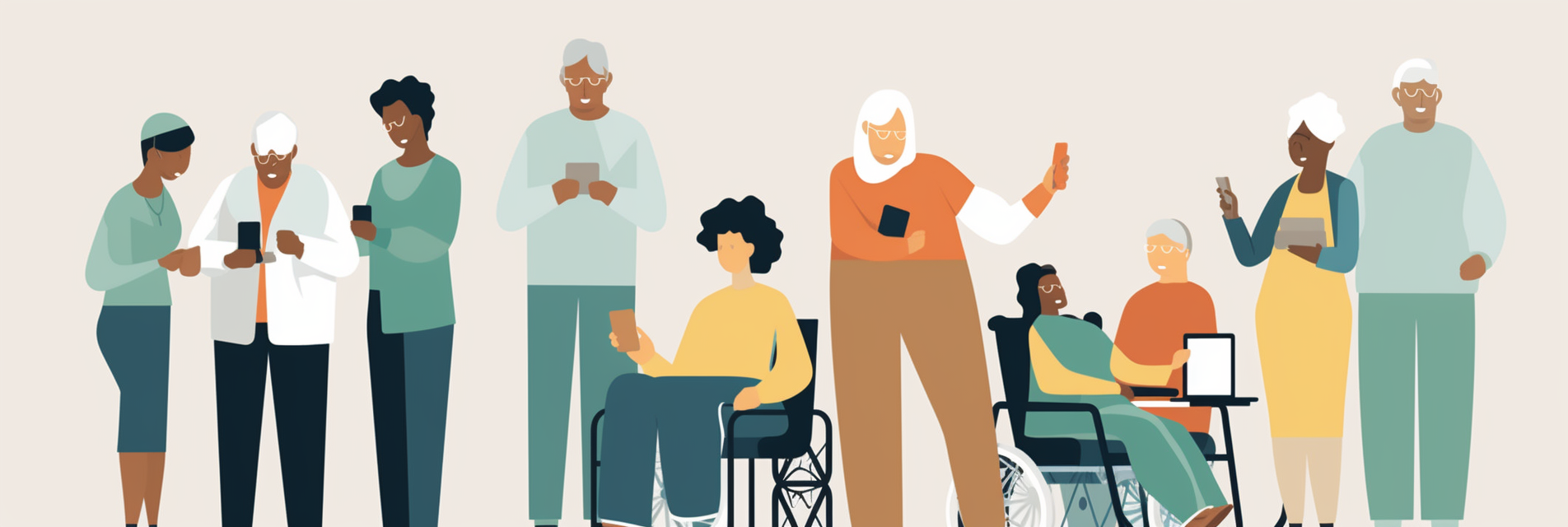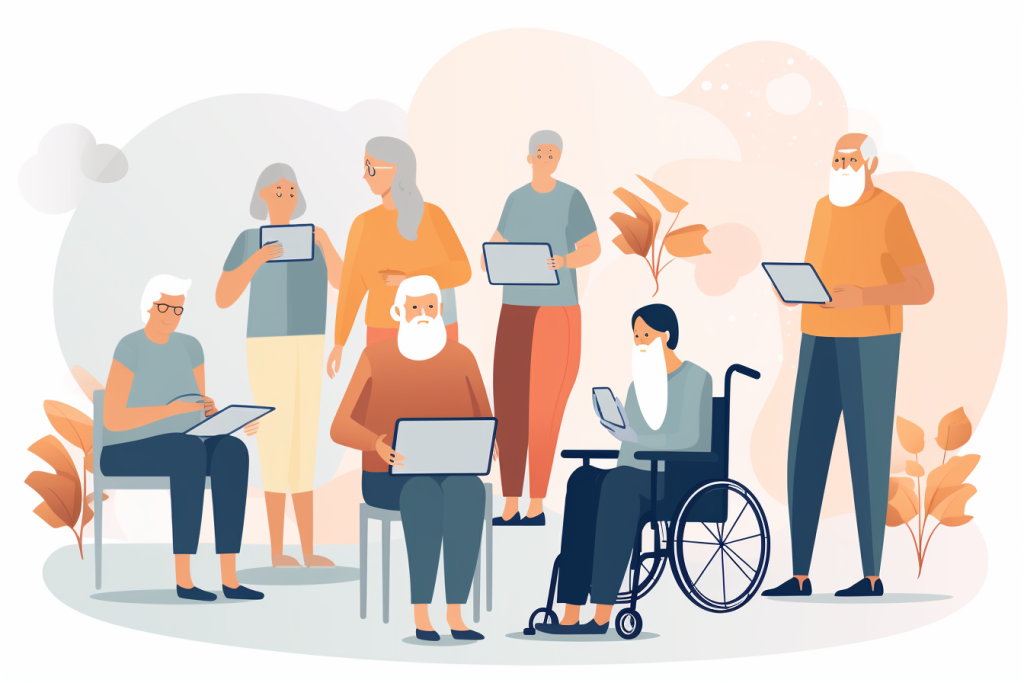effectively communicate our elder care servicesrtance of embracing diversity and inclusion. We recognize that each individual brings unique experiences, backgrounds, and perspectives that contribute to the richness of our communities.
In a world where people are more connected than ever, we need to create an online space that reflects this reality and caters to everyone seeking our support.
That’s why optimizing your elder care website for diversity should be at the top of your priority list. In this article, we’ll guide you through several key steps to make your elder care website inclusive and accessible to all users.
By incorporating inclusive language and imagery, highlighting your commitment to diversity and inclusion, offering multilingual content, and ensuring accessibility for all users, you can create a welcoming environment for those seeking help from your organization.
Let’s embark on this journey to create a more diverse and compassionate digital platform for elder care services!
Assess Your Current Website Content
Ready to evaluate your site’s content and ensure it speaks to a diverse audience? Dive in, and let’s make it happen!
Content evaluation is essential in determining whether your elder care website effectively communicates with people from different backgrounds, cultures, and lifestyles. By analyzing your site’s images, language, and topics, we can identify areas for improvement and create a more inclusive online space that resonates with everyone seeking elder care services.
Website analysis involves examining every aspect of your online presence – from the visuals to the text – to pinpoint gaps or biases that may unintentionally exclude certain groups.
Let’s embrace creativity as we work together to craft a compassionate and knowledgeable digital environment for our visitors. After all, our goal is to connect with those who subconsciously desire to serve others by providing quality elder care options.
By optimizing your elder care website for diversity, you’ll expand your reach and demonstrate genuine commitment towards inclusivity – something precious in today’s world.
Incorporate Inclusive Language and Imagery

To create a welcoming and inclusive elder care website, we must incorporate diverse stock photos and avoid stereotypes or assumptions in our language and imagery.
By doing so, we demonstrate compassion and understanding for all individuals seeking elder care and foster a sense of belonging for everyone who visits our site.
Let’s explore how selecting representative images and using inclusive language can significantly impact reaching a wider audience while promoting equity in elder care.
Use diverse stock photos.
Incorporate a variety of stock photos to showcase the inclusivity and welcoming atmosphere of your senior care services! By using diverse representation in the images on your website, you not only appeal to a broader audience but also demonstrate that you value and celebrate the unique backgrounds of each person.
Inclusive photography helps potential clients and their families feel welcomed, respected and understood – making them more likely to choose your services for their loved ones.
When selecting stock photos, be mindful of representing various ethnicities, genders, abilities, and ages. This attention to detail will resonate with visitors seeking a compassionate and knowledgeable care provider for their elderly family members.
In our opinion, by showcasing an inclusive approach through visuals on your site, you create a warm environment where everyone feels valued and included. Both potential clients and staff will appreciate this commitment to diversity as they seek the best possible elder care options.
Avoid stereotypes and assumptions.
Steer clear of stereotypes and assumptions, as they can effectively hinder your ability to connect with potential clients and their families. Cultural sensitivity and bias awareness are crucial in creating an inclusive elder care website that caters to the diverse needs of our aging population.
By avoiding generalizations about specific cultural, racial, or ethnic groups, we can foster a welcoming environment where everyone feels respected and valued. We must also recognize that each individual has unique preferences, beliefs, and traditions, which should be honoured when designing their care plan.
As compassionate caregivers, we strive for continual growth in understanding the diverse backgrounds of our community. This means actively seeking information on different cultures, religions, and ways of life to serve better all who come through our doors.
Let’s challenge ourselves to think outside the box regarding representing diversity on our elder care websites – from language options and accessibility features to showcasing personal stories from a wide range of individuals receiving care at our facilities. By doing so, we’ll create a more inclusive space and build trust with potential clients who see themselves reflected in the content we present.
Highlight Your Commitment to Diversity and Inclusion

Embracing the vibrant tapestry of various backgrounds and cultures, we proudly showcase our dedication to fostering a diverse and inclusive environment for all in our community.
We’ve implemented several measures that reflect cultural sensitivity and promote inclusive hiring practices to demonstrate our commitment to diversity and inclusion. We provide ongoing training for all staff members on cultural competency and sensitivity, ensuring they can effectively communicate with and care for individuals from diverse backgrounds through cultural sensitivity training.
By actively seeking out qualified candidates from different ethnicities, religions, gender identities, ages, abilities, and sexual orientations, we ensure that our team represents the same beautiful array of differences found within the communities we serve through inclusive hiring practices.
We regularly hold events and activities that celebrate the unique customs and traditions of various cultures represented by our residents and staff members, which fosters a sense of belonging and helps educate everyone about the richness of diversity in our community.
Overall, our commitment to diversity and inclusion is at the core of everything we do, and we strive to create an environment that is welcoming and supportive of everyone.
Offer Multilingual Content

By providing multilingual content, you’ll enhance communication and demonstrate your commitment to inclusivity and respect for diverse cultures. Cultural sensitivity is essential in the elder care sector, as it helps foster trust and understanding between caregivers, patients, and their families.
Integrating translation services into your website shows that you value open communication with everyone, regardless of their language or background. Offering multilingual resources can be a game-changer for those seeking elder care services.
Imagine the relief a family feels when they find a provider who speaks their language and understands their culture—it’s an invaluable gift that sets your organization apart from others. Ensuring all visitors to your site have access to information in their preferred language creates an environment where everyone feels welcome and cared for—ultimately leading to better outcomes for elders under your care.
Ensure Accessibility for All Users
As we strive to create an inclusive elder care website, we must ensure accessibility for all users. By following web accessibility guidelines and including alternative text for images and video captions, we can make our content easy to understand and navigate for individuals with diverse needs.
Let’s explore how we can prioritize accessibility while maintaining a compassionate, knowledgeable, and creative approach.
Follow web accessibility guidelines.
Ensure you’re meeting web accessibility standards, making accessing valuable information on the site easier for people of all abilities and backgrounds. By following these guidelines, we can create an inclusive design catering to a diverse audience. Not only does this help us serve others better, but it also demonstrates our commitment to compassion and empathy in providing essential elder care resources.
To make sure we’re doing our best in offering a user-friendly experience, consider implementing the following elements:
- Conduct regular accessibility audits to identify any barriers or shortcomings that need improvement.
- Use precise language and straightforward navigation structures that cater to users with varying cognitive abilities.
- Provide alternative multimedia content formats (such as audio descriptions or transcripts).
By prioritizing web accessibility, we can ensure that everyone who visits our elder care website feels welcomed and supported. This is key in fostering a sense of belonging within our community and helping individuals find the resources they need without undue stress or frustration.
Let’s continue striving for a more inclusive online presence so that we can better serve those who rely on us for guidance and support in their journey through elder care.
Include alternative text for images and video captions.
Incorporating alternative text for images and video captions is vital in creating a more inclusive online experience, enabling individuals with visual impairments to access crucial information without feeling excluded. By understanding the image importance and caption benefits, we can ensure that our elder care website caters to a diverse audience, making it easier for everyone to navigate and find the information they need.
To optimize our website for diversity, we must consider both the visual and auditory aspects of content accessibility. Here’s a table outlining some key points on how alternative text for images and video captions can significantly improve the user experience:
| Image Importance | Caption Benefits |
|---|---|
| Improves SEO | Enhances comprehension |
| Provides context | Engages diverse audience |
| Aids visually impaired | Supports hearing impaired |
Implementing these features demonstrates our commitment to serving others by ensuring all visitors feel welcome on our elder care website. In doing so, we create an engaging space and foster an environment where everyone can find valuable resources without facing barriers.
Frequently Asked Questions
How can we address the unique cultural and religious needs of diverse elder care clients on our website?
At the heart of our mission lies a kaleidoscope of cultural and religious backgrounds that make our elder care community genuinely vibrant. We believe in embracing Cultural Sensitivity and providing Religious Accommodations to ensure each individual feels respected, understood, and cared for.
Our commitment to honouring the unique needs of our diverse clients is woven into every aspect of our services, from creating personalized care plans to offering culturally relevant activities and celebrations. As champions of compassionate elder care, we’re passionate about fostering an environment where everyone can flourish—because when diversity thrives, so does the entire community.
What strategies can we implement to showcase our diverse staff and their expertise in providing culturally competent elder care services?
At our elder care facility, we proudly showcase our diverse staff and their expertise in providing culturally competent services. We invest in cultural sensitivity training for all team members to ensure they understand and respect each client’s unique cultural and religious needs.
In addition, we prioritize inclusive content creation by sharing stories of how our staff has successfully navigated these differences while providing exceptional care. By embracing diversity within our team, we create an environment where everyone feels valued, understood, and supported – allowing us to serve others with compassion, knowledge, and creativity.
How can we effectively communicate our elder care services to diverse communities with different expectations or experiences with aged care?
At our elder care facility, we understand the importance of meeting diverse communities’ unique needs and expectations when it comes to providing exceptional care for their loved ones. That’s why we invest in cultural sensitivity training for our staff, ensuring they have the knowledge and understanding needed to offer personalized, culturally competent services.
Additionally, we provide language accessibility options, making it easier for families from different backgrounds to navigate our resources and communicate their specific requirements effectively. By embracing these practices, we strive to create an inclusive environment where all seniors receive compassionate care honouring their individuality and respecting their cultural heritage.
Are there specific resources or organizations we can collaborate with to ensure our website provides accurate and relevant information for diverse elder care communities?
Did you know that nearly 20% of older adults in the United States speak a language other than English at home?
To provide the best elder care services, we’re partnering with local organizations and investing in cultural sensitivity training for our team members. By doing so, we can ensure that our website offers language accessibility options and accurately addresses the unique needs of diverse communities.
With compassion, knowledge, and creativity at the forefront, we strive to positively impact those who rely on us – because serving others isn’t just what we do; it’s who we are.
How can we measure the success of our diversity and inclusion efforts on our elder care website, and what improvements can we make based on user feedback or analytics data?
In our quest to create a genuinely inclusive and welcoming space, we’re committed to measuring the success of our diversity and inclusion efforts through user feedback and analytics data.
Incorporating inclusive language and cultural sensitivity can better serve communities with varying needs and backgrounds.
We’ll continually analyze our website’s performance, identify areas for improvement, and make necessary adjustments based on your valuable input.
Let’s cultivate an environment that empowers everyone toward compassionate elder care.
Conclusion
So, have we done enough to make our elder care website inclusive and accessible for everyone?
It’s time to take action and embrace diversity in our content, design, and messaging.
Together, let’s commit to creating a compassionate, knowledgeable online space that reflects the unique needs of each individual.
By doing so, we can better serve our diverse community and ensure no one’s left behind.



